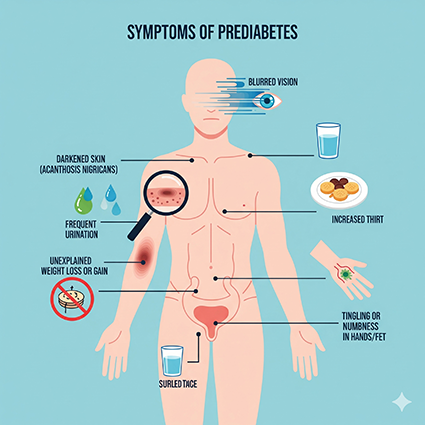Prediabetes: Symptoms and Management

Prediabetes is a condition where your blood sugar levels are higher than normal, but not yet high enough to be diagnosed as type 2 diabetes. While it often has no clear symptoms, it’s a serious health condition that increases your risk of developing type 2 diabetes, heart disease, and stroke.
Symptoms of Prediabetes
The most important thing to know is that prediabetes often has no noticeable symptoms. However, some people may experience subtle signs that are more commonly associated with full-blown type 2 diabetes. These can include:
Increased thirst and frequent urination: As your kidneys work to filter out excess sugar, you may feel thirsty and need to urinate more often, especially at night.
Fatigue: When your body’s cells can’t properly absorb glucose for energy, you may feel unusually tired or lethargic.
Blurred vision: High blood sugar levels can affect the fluid levels in your eyes, causing the lenses to swell and leading to temporary blurry vision.
Darkened skin: A common sign of insulin resistance, which is at the root of prediabetes, is the development of dark, velvety patches of skin, particularly on the neck, armpits, and groin. This condition is called acanthosis nigricans.
Increased hunger and unexplained weight loss: Even with an increased appetite, your body may start to burn muscle and fat for energy because it can’t use glucose properly, leading to unintentional weight loss.
Slow-healing cuts or sores: High blood sugar can damage blood vessels and nerves, impairing the body’s ability to heal.
If you have any of these symptoms or are at a higher risk for prediabetes, it’s important to talk to your doctor and get a blood test to check your blood sugar levels.
Risk Factors for Prediabetes
You may be at higher risk for prediabetes if you:
Are overweight or obese.
Are 45 years or older.
Have a family history of type 2 diabetes.
Are physically active less than three times a week.
Have a history of gestational diabetes.
Have polycystic ovary syndrome (PCOS).
Are of a certain race or ethnicity (African American, Hispanic or Latino American, American Indian, Pacific Islander, and some Asian Americans are at higher risk).
Management of Prediabetes
The good news is that for many people, prediabetes is reversible. Lifestyle changes are the most effective way to manage the condition and prevent or delay the progression to type 2 diabetes.
- Lifestyle Changes:
Eat a healthy diet: Focus on a diet rich in fruits, vegetables, lean proteins, and whole grains. Limit processed foods, sugary drinks, and foods high in saturated and trans fats.
Increase physical activity: Aim for at least 150 minutes of moderate-intensity aerobic activity per week, such as brisk walking, or 75 minutes of vigorous activity. Physical activity helps control your weight, uses up sugar for energy, and improves your body’s response to insulin.
Lose excess weight: Losing just 5% to 7% of your body weight can significantly reduce your risk of developing type 2 diabetes.
Quit smoking: Smoking can increase insulin resistance.
- Medical Management:
Regular check-ups: If you’re diagnosed with prediabetes, your healthcare provider will likely want to check your blood sugar levels at least once a year.
Medication: In some cases, your doctor may recommend medication, such as metformin, especially if you are at high risk for diabetes.
Working with your doctor, a registered dietitian, or a certified diabetes educator can help you create a personalized plan to manage your prediabetes and improve your overall health